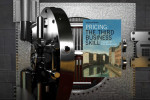Getting to Plan B: Analogs, Antilogs and Leaps of Faith

Many companies become successful after pivoting, iterating, or completely rewriting their original business plans, assumptions, and business models. Since no plan survives contact with reality, businesses often find themselves upturning initial assumptions and models.
Getting to Plan B: Breaking Through to a Better Business Model by John Mullins and Randy Komisar
Plans don’t survive encounters with reality
All businesses begin with an optimistic Plan A which charts their desired path to success. Few Plan As survive encounters with reality and most end up as a Plan B. Mullins and Komisar propose planning up front for the eventual Plan B on your horizon. If you know that you will have to adapt and change your original perspective, why not start with that eventuality in mind?
Getting to Plan B offers several tools for learning and testing on your way to a successful business model. Analogs and antilogs are examples of prior companies which have taken the path you want to take or an opposite path. In both cases, you can learn a lot from what others have done, taking the strategies that benefit your situation. Leaps of faith are the fundamental assumptions you make about your business. Those assumptions are hypotheses which need to be tested and examined for usefulness.
Mullins and Komisar observe that many businesses change their business model and fundamental assumptions in their evolution. Success often comes with Plan B, Plan C or later. This path involves asserting hypotheses and experimenting to determine what will work and what will not.
Iterate to Plan B
Getting to Plan B outlines the process for putting together your “Plan A” and iterating your way to to Plan B. Key elements of getting to to Plan A, Plan B, and beyond are: analogs (examples of companies doing similar things), antilogs (counterexamples or examples of failed approaches) and leaps of faith (provisional answers to fundamental questions about your enterprise). That knowledge forms the basis of your experimental way forward. The authors uses five business model elements (revenue, gross margin, operating model, working capital, and investment) as the basis for case studies which examine how companies have changed their approach.
Our working assumption is that part or all of Plan A is wrong.
Mullins and Komisar advocate carefully designing your business model as you create the other parts of your plan because it’s easy to lose sight of financial basics in the excitement about new ideas and market opportunities.
The uncertainty that surrounds most innovations and most new ventures can be significantly mitigated by comparing the plan on the table to other businesses already in existence
Analogs & Antilogs
There’s no point in reinventing the wheel when key elements of it already exist.
Analogs are useful because it’s likely that whatever it is you’re doing has been been done before to some extent so you can use what other people have learned to formulate your own plan. This saves you time and resources because you can essentially borrow or steal approaches that have been proven to work or can serve as models for what you want to achieve. Many entrepreneurs have attempted or been successful with aspects of whatever enterprise you’re launching so why not learn from them and take advantage of their experience. Mullins and Komisar advise: “whatever you, don’t start from scratch.” A key examples in the book is Apple’s transition from PC hardware and software to consumer electronics and music distribution. Analogs for Apple were the Sony Walkman, the Rio and Napster.
Looking to previous failures and contrasting approaches is an instructive way to construct your approach. Antilogs can provide useful counterpoints or signposts for lurking danger. Antilogs and analogs help you avoid re-inventing the wheel and leapfrog into the next set of questions and uncertainties. Mixing and matching the best from those who came before you can give you the best of both worlds.
Leaps of Faith
The questions you cannot answer from historical precedent lead to your leaps of faith–beliefs you hold about the answers to your questions despite having no real evidence these beliefs are actually true.
Once you’ve positioned and designed your venture in relation to your analogs and antilogs it’s time to identify the handful of questions that are key to the value you will be delivering to your customers. That’s where “leaps of faith” come in. Mullins and Komisar say you now need to make your best guess and jump. Leaps of faith are essentially hypotheses you will test by experimentation. Examples of leaps of faith are affirmative answers to questions like “will people buy and listen to music privately in a social setting?” and “will people legally download music to a portable device?”.
Dashboards
A dashboard is a tool that drives an evidence-based process to plan, guide, and track the results of what you learn from your hypothesis testing.
The Plan B process involves creating a dashboard grid which identifies analogs, antilogs, and leaps of faith for each of the five business model elements. This allows you to quickly compare your assumptions and hypotheses for each of your business model elements. Your dashboard should include hypotheses, metrics, actuals, and insights for each Leap of Faith. Recording assumptions enables founders to focus on the largest risk areas and visualize how their business evolves. Although hypotheses tend to be qualitative, they are backed by quantitative metrics. The dashboard becomes “a list of critical tasks for key functional leaders” to use as measurable objects and with which to establish priorities.
The analog, antilog, and leap of faith process is repeated for each business model element to fine tune each and arrive at a complete view of your entire business model. As a result, the business model grid is a matrix of business model elements juxtaposed with their associated analogs, antilogs, leaps of faith, and hypotheses.
As the authors discuss the business models of companies like eBay, Toyota, Patagonia, and Silverglide, they highlight the strongest element in each company’s business model. eBay, Toyota, and Patagonia are shown to have strong gross margin approaches while Google and Silverglide were able to modify and invent new revenue models. In a concluding chapter, Mullins and Komisar discuss how the five business model elements interrelate.






